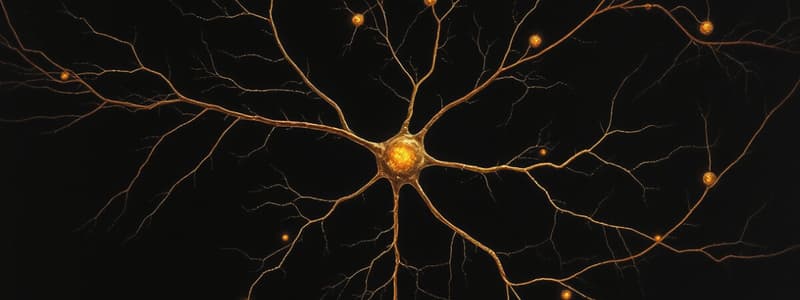Podcast
Questions and Answers
What are Anaxonic Neurons characterized by?
What are Anaxonic Neurons characterized by?
- Function well understood
- Dendrites and axon are distinguishable
- Located in the spinal cord
- All cell processes look alike (correct)
What does it mean when neurons are classified as unipolar?
What does it mean when neurons are classified as unipolar?
They have a continuous dendrite and axon with the cell body off to one side.
What do Bipolar Neurons consist of?
What do Bipolar Neurons consist of?
- Many axons
- Two axons and one dendrite
- One axon and one dendrite (correct)
- Three axons
Neurons can be categorized based on their function as _____, motor, and interneurons.
Neurons can be categorized based on their function as _____, motor, and interneurons.
What type of neurons are most common in the CNS?
What type of neurons are most common in the CNS?
What is the function of sensory neurons?
What is the function of sensory neurons?
Interneurons outnumber all other types of neurons combined.
Interneurons outnumber all other types of neurons combined.
What is the role of Ependymal cells?
What is the role of Ependymal cells?
Match the following types of neuroglia with their functions:
Match the following types of neuroglia with their functions:
Flashcards are hidden until you start studying
Study Notes
Classification of Neurons
- Neurons are classified based on the structure and the relationship of their dendrites to the cell body and axon: anaxonic, bipolar, unipolar, and multipolar.
Anaxonic Neuron
- Small neurons with no clear distinction between dendrites and axons.
- All cellular processes appear similar, making identification challenging.
- Primarily located in the brain and specific sensory organs; their functions are not well understood.
Unipolar (Pseudounipolar) Neurons
- Dendrites and axon are continuous and fused, with the cell body positioned to one side.
- Most sensory neurons in the peripheral nervous system are classified as unipolar.
- The initial segment of the neuron lies where the dendrites converge.
- Axons can extend long distances, reaching synapses in the central nervous system.
Bipolar Neurons
- Characterized by having one dendrite and one axon with the cell body situated between them.
- Rare compared to other neuron types and primarily found in special sense organs (sight, smell, hearing).
- Dendrites branch extensively at the distal ends, providing specialized sensory functions.
Multipolar Neurons
- Most common neuron type in the central nervous system with multiple dendrites and a single axon.
- Responsible for motor control, particularly to skeletal muscles.
- Can have long axons, sometimes extending as far as unipolar neurons.
Neuron Functions
- Neurons can be categorized into three functional types: sensory neurons (afferent), motor neurons (efferent), and interneurons (integrative).
Sensory Neurons
- Deliver sensory information from receptors to the central nervous system.
- Typically unipolar with cell bodies located in sensory ganglia.
- Afferent fibers extend between sensory receptors and the CNS.
- Somatic sensory neurons monitor external environments; visceral sensory neurons monitor internal conditions.
Sensory Receptors
- Specialized processes or cells that gather information on external and internal stimuli.
- Types include interoceptors (internal organs), exteroceptors (external environment), and proprioceptors (skeletal muscle/joint position).
Motor Neurons
- Carry instructions from the CNS to peripheral effectors, including smooth and cardiac muscles, glands, and adipose tissues.
- Somatic motor neurons innervate skeletal muscles, while visceral motor neurons control involuntary muscles and glands.
Interneurons
- Represent the largest group of neurons in the brain and spinal cord, facilitating communication between sensory and motor neurons.
- Involved in complex responses to stimuli and higher-order functions such as memory and learning.
Neuroglia in the CNS
- Four main types: ependymal cells, astrocytes, oligodendrocytes, and microglia.
- Ependymal cells line brain ventricles and aid in cerebrospinal fluid production and circulation.
- Astrocytes maintain the blood-brain barrier and support neurons by regulating extracellular conditions.
- Oligodendrocytes myelinate CNS axons and provide structural support.
- Microglia act as the immune defense by phagocytizing debris and pathogens.
Neuroglia in the PNS
- Two types: satellite cells and Schwann cells.
- Satellite cells regulate environmental conditions around neuron cell bodies in ganglia.
- Schwann cells myelinate peripheral axons and play a crucial role in nerve repair following injury.
Studying That Suits You
Use AI to generate personalized quizzes and flashcards to suit your learning preferences.
